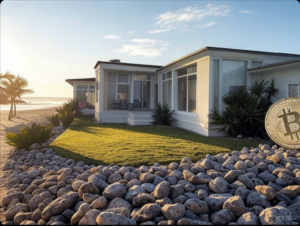Posted on March 21, 2025
Land Banking vs Bitcoin Investment
 Land Banking: Buying undeveloped land to hold until its value rises, typically due to development, population growth, or infrastructure projects. It’s a physical, long-term asset.
Land Banking: Buying undeveloped land to hold until its value rises, typically due to development, population growth, or infrastructure projects. It’s a physical, long-term asset.
Bitcoin: A decentralized cryptocurrency with a capped supply of 21 million coins, seen as a speculative investment and inflation hedge. It’s digital and highly liquid.
Comparison Factors
Historical Returns
Land Banking: Land appreciates steadily but slowly. In the U.S., average annual land value growth is 3-5% (inflation-adjusted), per Federal Housing Finance Agency data. In high-demand areas (e.g., near growing cities), returns can hit 10-15% annually, but these are outliers.
Bitcoin: Bitcoin’s past performance is volatile but stellar. From 2015 to 2025, its compounded annual growth rate (CAGR) averages 40-50%, despite crashes (e.g., 70%+ drops in 2018 and 2022). In 2024, it surged over 100%, fueled by ETF approvals and broader acceptance.
Edge: Bitcoin, with vastly higher historical gains.
Projected Returns (2025-2035)
Land Banking: Future returns hinge on location and economic trends. A realistic average might be 4-7% annually in stable markets, with 10-12% possible in high-growth regions (e.g., emerging suburbs or developing countries). Gains often take 10-20 years to fully materialize.
Bitcoin: Predictions range widely. A conservative estimate, factoring in maturing markets and reduced volatility, is 15-20% annualized, driven by halving cycles (e.g., 2028) and adoption. Bullish forecasts (e.g., $1M+ by 2035) suggest 30%+ CAGR, while bearish ones (~5%) align with land’s upper end. A middle-ground projection: 15-20%.
Edge: Bitcoin, with greater upside potential.
Risk and Volatility
Land Banking: Low to moderate risk. Land is tangible and less volatile, but risks include zoning changes, environmental issues, or economic downturns. Price swings are rare, tied to real estate cycles.
Bitcoin: High risk, high volatility. Prices can drop 20-30% in days due to market sentiment, regulation, or tech risks (e.g., network vulnerabilities). Long-term holders argue volatility decreases over time.
Edge: Land banking, for stability.
Liquidity
Land Banking: Illiquid. Selling undeveloped land can take months or years, with high transaction costs (taxes, fees). It’s a “buy and hold” play.
Bitcoin: Highly liquid. You can trade it instantly on exchanges, 24/7, with minimal costs via platforms like Coinbase or Binance.
Edge: Bitcoin, no contest.
Costs and Maintenance
Land Banking: Ongoing costs include property taxes, maintenance (even if minimal), and potential legal fees. Initial capital outlay is high, often requiring loans or large cash reserves.
Bitcoin: Low costs. No maintenance, just exchange fees (0.1-1%) or wallet storage (negligible). Entry is flexible—buy $100 or $1M worth.
Edge: Bitcoin, for lower overhead.
Inflation Hedge
Land Banking: Reliable hedge. Land tends to rise with inflation, though returns can lag during rapid price spikes unless development occurs.
Bitcoin: Positioned as an inflation hedge due to its fixed supply. Its performance in high-inflation periods (e.g., 2021-2022) has been inconsistent, but long-term faith in its scarcity persists.
Edge: Slight lean to land banking, but Bitcoin’s narrative is catching up.
Numbers-Based Projection (2025-2035)
Let’s model a $10,000 investment over 10 years:
Land Banking:
Annual return: 6% (mid-range estimate).
After 10 years: $10,000 × (1.06)^10 = ~$17,908.
Profit: $7,908.
High-growth scenario (10%): $25,937, profit $15,937.
Bitcoin:
Annual return: 17.5% (midpoint of 15-20% conservative estimate).
After 10 years: $10,000 × (1.175)^10 = ~$49,844.
Profit: $39,844.
Bullish (30%): $137,858; Bearish (5%): $16,289.
Bitcoin’s baseline beats land’s best-case scenario, and its ceiling is exponentially higher.
Which Comes Out on Top?
Based on the numbers, Bitcoin is poised to outperform land banking over the next 10 years (2025-2035). Here’s the reasoning:
Higher Returns: Bitcoin’s projected 15-20% annual growth far exceeds land banking’s 4-7% (or even 10-12% in optimal cases).
Liquidity: Bitcoin’s ease of trading suits investors seeking flexibility, while land ties up capital.
Growth Trajectory: Bitcoin benefits from increasing adoption, scarcity (halvings), and global digital trends, while land banking relies on slower, localized factors.
Caveats: Land banking wins for those prioritizing safety and tangible assets. Bitcoin’s volatility could lead to losses if timed poorly, and regulatory shifts could cap its growth. Still, its risk-reward profile favors higher returns.
Verdict: Bitcoin comes out on top, potentially delivering 2-5x the profit on 10 year investment of land banking by 2035, assuming moderate adoption and market stability.
20 – 30 Year Projection
Bitcoin comes out on top, potentially yielding 3-10x the profit on 30 year investment of land banking by 2055, assuming moderate growth and market survival. The numbers favor its higher risk-reward profile for long-term investors.





 Bitcoin
Bitcoin  Ethereum
Ethereum  Tether
Tether  XRP
XRP  Dogecoin
Dogecoin  Bitcoin Cash
Bitcoin Cash  Monero
Monero  Zcash
Zcash  Litecoin
Litecoin  Solana
Solana  PAX Gold
PAX Gold